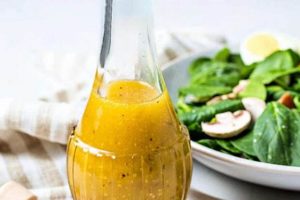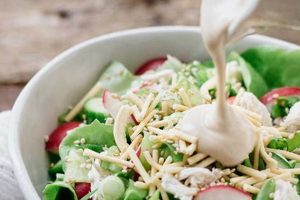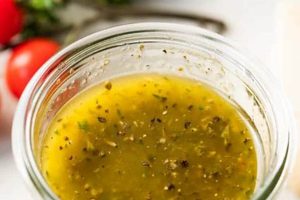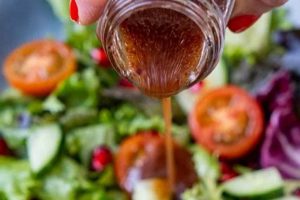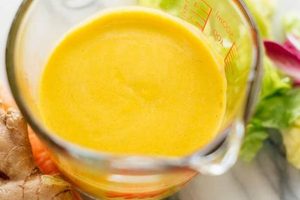Vinaigrettes, creamy dressings based on yogurt, buttermilk, or tahini, and flavorful blends utilizing fruit purees or avocado offer diverse alternatives to traditional oil-based dressings. These recipes typically combine an acidic element like vinegar or citrus juice with flavor enhancers such as herbs, spices, and aromatics. An example is a simple lemon-herb vinaigrette made with fresh lemon juice, Dijon mustard, minced garlic, and chopped parsley.
The increasing popularity of these dressings stems from a growing awareness of dietary fat and calorie intake. Eliminating oil significantly reduces the caloric density of dressings, benefiting those seeking weight management or adhering to specific dietary restrictions. Furthermore, some individuals may avoid oil due to allergies or intolerances. Historically, oil-based dressings were less prevalent due to the expense and availability of oil. Traditional dressings often relied on acidic elements and flavorings readily accessible in home gardens and kitchens.
The following sections will explore various techniques and ingredients for creating flavorful, healthful dressings that enhance salads without relying on oil, encompassing classic vinaigrettes, creamy emulsions, and unique fruit-based options. Recipe examples will be provided to illustrate the versatility and delicious potential of oil-free dressings.
Tips for Crafting Delicious Oil-Free Salad Dressings
Creating flavorful salad dressings without oil requires attention to balance and texture. The following tips offer guidance for achieving delicious results.
Tip 1: Embrace the Power of Acid. Acidity provides the foundational structure of most oil-free dressings. Lemon juice, vinegar (balsamic, red wine, apple cider), and even citrus zest contribute brightness and complexity.
Tip 2: Explore Flavorful Bases. Beyond vinegar, explore bases like yogurt, buttermilk, tahini, or pureed fruits (berries, mango). These ingredients add creaminess and unique flavor profiles.
Tip 3: Enhance with Aromatics. Fresh herbs (parsley, dill, chives), minced garlic, shallots, or ginger elevate dressings beyond simple acidity. Experiment with combinations to create signature flavors.
Tip 4: Balance Sweetness and Spice. A touch of sweetness, from honey, maple syrup, or a pinch of sugar, can balance sharper flavors. A dash of red pepper flakes or a pinch of cayenne adds warmth and complexity.
Tip 5: Consider Texture. Blended dressings provide a smooth, creamy consistency. Alternatively, finely chopped ingredients create a more textured experience.
Tip 6: Emulsify for Creaminess. For creamy dressings without oil, an emulsifier like Dijon mustard or a small amount of silken tofu can help bind ingredients and create a smooth, cohesive texture.
Tip 7: Season Judiciously. Salt and freshly ground black pepper are essential. Taste and adjust seasonings throughout the preparation process.
By understanding the interplay of these elements, crafting exceptional oil-free dressings becomes readily achievable. These techniques empower experimentation and culinary creativity, resulting in dressings tailored to individual preferences.
The following section will provide specific recipe examples demonstrating these principles in action.
1. Flavorful Acid Base
Flavorful acid bases form the cornerstone of successful oil-free salad dressings. They provide not only the essential tartness that balances other flavors but also contribute significantly to the overall structure and character of the dressing. Without the lubricating quality of oil, the acid component takes on an even more critical role in creating a palatable and enjoyable dressing. The acid’s interaction with other ingredients, particularly spices and herbs, creates a synergistic effect, enhancing their individual flavors and contributing to the complexity of the final product. A lemon-herb vinaigrette, for example, relies on the lemon juice to brighten the herbaceous notes of parsley and thyme, creating a vibrant and refreshing flavor profile.
Acids perform several crucial functions in oil-free dressings. They act as natural preservatives, extending the shelf life of the dressing. Their tartness cuts through the richness of certain salad ingredients, creating a more balanced flavor experience. Furthermore, specific acids contribute unique flavor profiles. The sharpness of lime juice complements Southwestern flavors, while the mellow tang of apple cider vinegar enhances the sweetness of fruit-based dressings. Understanding the nuances of different acids allows for greater control over the final flavor profile. For instance, the deep, almost sweet acidity of balsamic vinegar can be used to create a rich, complex dressing when paired with Dijon mustard and a touch of maple syrup.
Effective oil-free dressing formulation hinges on a careful selection of acid and an understanding of its interaction with other ingredients. The choice of acid should complement the overall flavor profile of the salad. While citrus juices provide a bright, refreshing acidity, vinegars offer a wider range of flavor complexities, from the fruity notes of raspberry vinegar to the smoky depth of sherry vinegar. Mastering the use of flavorful acid bases allows for the creation of diverse and delicious dressings that enhance, rather than mask, the flavors of the salad itself.
2. Creative Emulsifiers
Emulsification, the process of combining two immiscible liquids like oil and water, is crucial for creating the desired texture and stability in traditional salad dressings. In oil-free versions, creative emulsifiers become essential for achieving a similar creamy consistency and preventing separation. These emulsifiers act as binding agents, holding the disparate ingredients together and providing a homogenous, visually appealing dressing. Without oil to act as the binding agent, alternative ingredients must be employed to achieve this crucial function. These substitutes often introduce additional flavor complexities, expanding the potential for creating unique and delicious dressings.
Several ingredients effectively emulsify oil-free dressings. Silken tofu, due to its high protein content and smooth texture, blends seamlessly into dressings, creating a creamy base without imparting a strong flavor. Nut butters, particularly tahini and cashew butter, offer richness and a slightly nutty flavor while effectively binding the dressing. Avocado, rich in healthy fats and creamy in texture, serves as both an emulsifier and a flavor enhancer. Other options include cooked and pureed starchy vegetables like sweet potatoes or cauliflower, which add body and subtle sweetness while contributing to emulsification. For example, a dressing might combine roasted red pepper puree, balsamic vinegar, and a touch of Dijon mustard to create a smooth, flavorful emulsion.
The selection of an appropriate emulsifier significantly impacts the final flavor, texture, and nutritional profile of the oil-free dressing. Silken tofu provides a neutral base, allowing other flavors to shine, while nut butters add a distinct richness. Avocado lends a creamy texture and healthy fats. Understanding these nuances allows for informed choices tailored to specific dietary preferences and desired flavor outcomes. Effectively utilizing creative emulsifiers expands the possibilities of oil-free dressings, allowing for the creation of diverse, delicious, and visually appealing options that rival traditional oil-based counterparts.
3. Fresh Herbs and Spices
Fresh herbs and spices play a vital role in elevating oil-free salad dressings beyond simple acidic mixtures. In the absence of oil, which often carries subtle flavors and contributes to a rounded mouthfeel, herbs and spices become crucial for building complexity and depth. They provide the aromatic dimension that might otherwise be lacking, transforming a basic vinaigrette into a vibrant, flavorful experience. The careful selection and combination of herbs and spices allow for a wide range of flavor profiles, from bright and herbaceous to warm and earthy. For example, a simple lemon vinaigrette gains significant complexity with the addition of fresh dill and a pinch of black pepper. The dill contributes a fresh, slightly anise-like flavor, while the black pepper adds a subtle warmth and bite. This interplay of flavors creates a dressing that is far more interesting than the sum of its parts.
The inherent freshness of herbs offers a counterpoint to the sometimes assertive nature of acidic ingredients. The vibrant flavors of parsley, mint, or cilantro can soften the sharpness of vinegar or citrus juice, creating a more balanced and palatable dressing. Spices, whether used whole or ground, contribute warmth and complexity. A pinch of cumin can add an earthy depth to a lime-based dressing, while a dash of cayenne pepper introduces a subtle heat. Furthermore, the use of fresh herbs and spices aligns with broader culinary trends emphasizing natural, whole-food ingredients. A dressing made with fresh herbs and spices not only tastes better but also offers potential nutritional benefits, contributing antioxidants and other beneficial compounds to the overall meal. For instance, a dressing featuring fresh oregano and thyme not only delivers a Mediterranean flavor profile but also provides antioxidants known for their health-promoting properties.
Maximizing the impact of fresh herbs and spices in oil-free dressings requires careful consideration. Freshly chopped herbs offer the most vibrant flavor and aroma, while dried herbs, used sparingly, can provide a concentrated flavor boost. Whole spices, toasted and ground, offer the most intense flavor, but pre-ground spices offer convenience. Balancing the proportions of herbs and spices is essential for achieving a harmonious flavor profile. Overpowering the dressing with too much of a single spice can mask the other flavors, while too little might not provide sufficient complexity. Understanding these nuances empowers the creation of oil-free dressings that are not only healthy and flavorful but also offer a sophisticated culinary experience.
4. Textural Elements
Oil-free salad dressings, while offering health benefits, sometimes lack the textural complexity contributed by oil. Incorporating textural elements becomes crucial for creating a more satisfying and enjoyable sensory experience. These elements provide contrasting textures, adding interest and depth to the overall culinary experience. Understanding the role of textural elements allows for a more nuanced approach to crafting oil-free dressings that are not only flavorful but also offer a pleasing mouthfeel.
- Seeds and Nuts
Finely chopped nuts, such as walnuts or pecans, and seeds, like toasted sesame or sunflower seeds, introduce a satisfying crunch and nutty flavor. These additions create a textural contrast against the smoother base of the dressing, preventing a monotonous experience. The choice of nut or seed should complement the overall flavor profile of the dressing and salad. For instance, toasted pumpkin seeds pair well with a maple-mustard vinaigrette, while slivered almonds complement a lemon-herb dressing.
- Minced Vegetables
Finely diced vegetables like bell peppers, red onion, or celery offer a crisp, refreshing texture. These additions not only introduce textural variety but also contribute subtle flavors that enhance the overall complexity of the dressing. For example, minced shallots add a subtle sharpness to a balsamic vinaigrette, while finely diced cucumber provides a refreshing coolness. The choice of vegetable should complement the other ingredients in the dressing and salad.
- Fruit Pieces
Incorporating small pieces of fruit, such as diced apples, berries, or grapes, introduces a juicy burst of flavor and textural contrast. This technique is particularly effective in fruit-based dressings, where the fruit acts as both a flavoring and a textural element. For instance, a raspberry vinaigrette can be enhanced with finely diced raspberries, providing a burst of fresh flavor and a pleasant textural variation. The choice of fruit should complement the overall flavor profile of the dressing and salad.
- Pulses and Grains
Cooked and slightly mashed pulses, like lentils or chickpeas, or cooked grains, such as quinoa or barley, contribute a hearty, slightly chewy texture. These additions not only provide textural interest but also add protein and fiber, enhancing the nutritional value of the salad. For example, a lemon-tahini dressing can be enhanced with cooked and lightly mashed lentils, creating a more substantial and satisfying dressing. The choice of pulse or grain should complement the overall flavor profile of the dressing and salad.
By strategically incorporating these textural elements, oil-free dressings become more engaging and satisfying. The interplay of textures adds a dimension often missing in dressings that rely solely on smooth bases. This mindful approach to texture elevates the overall culinary experience, demonstrating that healthy eating can be both flavorful and enjoyable.
5. Balanced Sweetness
Balanced sweetness plays a crucial role in oil-free salad dressing formulations. Without the richness and mouthfeel contributed by oil, sweetness becomes a critical component for achieving a harmonious flavor profile. It tempers the acidity of vinegar or citrus juice, preventing the dressing from becoming overly tart. Furthermore, it adds depth and complexity, enhancing the overall sensory experience. Properly balanced sweetness elevates oil-free dressings, ensuring they are palatable and complement the flavors of the salad ingredients.
- Natural Sugars from Fruits
Fruit purees or juices, such as berries, mangoes, or apples, contribute natural sweetness and enhance the flavor profile of oil-free dressings. These natural sugars offer a nuanced sweetness, often accompanied by complementary fruity notes. For instance, a mango puree not only sweetens a lime-based dressing but also adds a tropical fruit dimension.
- Honey and Maple Syrup
Small amounts of honey or maple syrup provide a more pronounced sweetness and distinct flavor profiles. Honey offers floral notes, while maple syrup imparts a characteristic caramel-like flavor. These natural sweeteners can be used to balance the tartness of vinegar and add depth to the dressing. For example, a balsamic vinaigrette benefits from a touch of honey, which complements the balsamic’s inherent sweetness.
- Agave and Other Liquid Sweeteners
Agave nectar and other liquid sweeteners offer a neutral sweetness, allowing other flavors in the dressing to shine. These sweeteners are useful when a clean, sweet taste is desired without introducing additional flavor complexities. For example, a simple lemon-herb vinaigrette can be balanced with a touch of agave nectar without altering its herbaceous character.
- Balancing Sweetness with Acidity
The key to successful oil-free dressings lies in achieving a harmonious balance between sweetness and acidity. Too much sweetness can make the dressing cloying, while insufficient sweetness can result in an overly tart flavor. Careful tasting and adjustment are crucial for achieving the desired balance. This interplay of sweet and sour creates a dynamic flavor profile that enhances the overall salad experience. A raspberry vinaigrette, for instance, relies on the balance between the sweetness of the raspberries and the tartness of the vinegar to create a vibrant, refreshing flavor.
By understanding the role of balanced sweetness and utilizing appropriate sweeteners, oil-free dressings can achieve flavor complexity and palatability that rival traditional oil-based counterparts. This careful attention to sweetness ensures that the absence of oil does not compromise the overall dining experience but rather opens up opportunities for creative and flavorful combinations.
Frequently Asked Questions about Oil-Free Salad Dressings
This section addresses common inquiries regarding the preparation and use of oil-free salad dressings.
Question 1: Do oil-free dressings cling to salad greens as effectively as oil-based dressings?
While oil inherently contributes to coating and clinging, oil-free dressings can adhere well with proper emulsification techniques. Using ingredients like silken tofu, nut butter, or avocado helps create a creamy consistency that coats greens effectively. Additionally, ensuring the greens are thoroughly dry before dressing helps prevent the dressing from becoming diluted.
Question 2: How can oil-free dressings achieve a rich, flavorful profile without oil?
Flavor depth in oil-free dressings relies on robust ingredients like flavorful vinegars, fresh herbs, spices, and aromatic vegetables. Ingredients like roasted garlic, sun-dried tomatoes, or miso paste contribute umami and complexity. Proper balancing of acidity, sweetness, and savory elements is essential.
Question 3: What are the primary health benefits of choosing oil-free dressings?
Oil-free dressings significantly reduce calorie and fat intake compared to traditional oil-based options. This can be beneficial for individuals managing weight or following specific dietary guidelines. Furthermore, eliminating certain oils may address allergy or intolerance concerns.
Question 4: How long can oil-free dressings be stored?
Storage duration varies depending on the ingredients. Generally, oil-free dressings can be stored in airtight containers in the refrigerator for up to a week. Dressings containing fresh herbs or fruits may have a shorter shelf life. Always check for signs of spoilage before consumption.
Question 5: Can oil-free dressings be used for purposes beyond salads?
Absolutely. Oil-free dressings offer versatility beyond salads. They can be used as marinades for vegetables, tofu, or tempeh; as dips for crudits or chips; or as sauces for grain bowls or roasted vegetables. Their lighter texture and fresh flavors lend themselves to various culinary applications.
Question 6: Are oil-free dressings suitable for all types of salads?
While suitable for most salads, the choice of dressing should complement the salad’s ingredients. A light vinaigrette works well with delicate greens, while a creamy cashew-based dressing might be better suited for heartier salads with roasted vegetables or grains. Consider flavor pairings when selecting or creating an oil-free dressing.
Oil-free dressings offer a healthy and flavorful approach to enjoying salads and other dishes. Understanding their preparation, storage, and versatility allows for informed choices that align with dietary preferences and culinary goals.
The following section will explore specific oil-free salad dressing recipes.
Conclusion
Exploration of salad dressing recipes without oil reveals a versatile and flavorful landscape beyond traditional oil-based counterparts. Emphasis on flavorful acid bases, creative emulsifiers, fresh herbs and spices, textural elements, and balanced sweetness allows for the creation of dressings that are not only health-conscious but also offer complex and satisfying flavor profiles. Techniques for maximizing flavor and texture in the absence of oil demonstrate that healthy eating need not compromise culinary enjoyment. Addressing frequently asked questions provides practical guidance for preparation, storage, and versatile applications of these dressings.
The increasing awareness of dietary preferences and health-conscious choices positions oil-free salad dressings as a significant culinary trend. Exploration and experimentation with diverse ingredients and techniques offer a path towards more healthful and flavorful meals. This shift encourages a broader perspective on salad dressings, viewing them not merely as condiments but as integral components of a balanced and enjoyable culinary experience.

